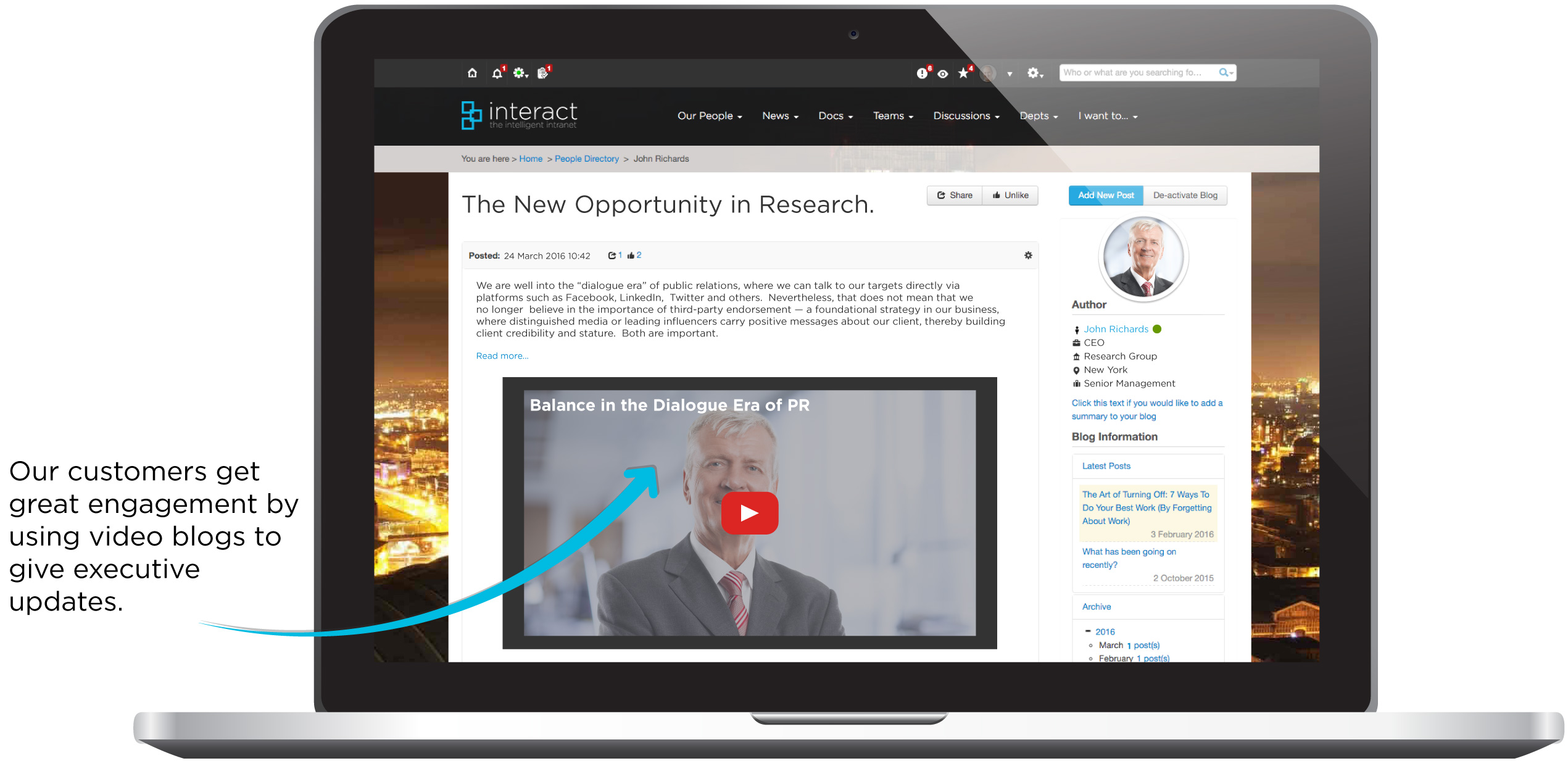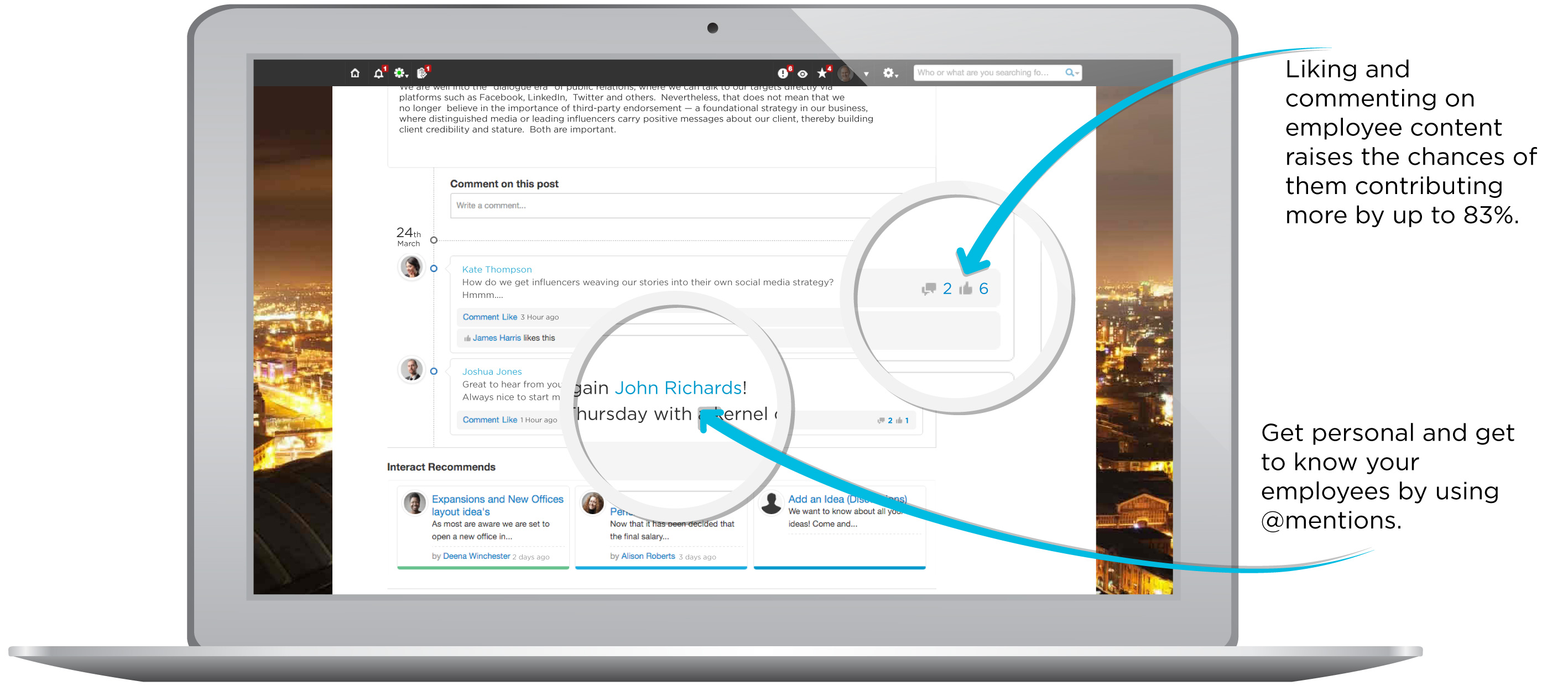How leading by example brings success in the digital workplace
As the experience of work pushes further into the digital realm, senior management is sometimes wary of using social technologies, as we heard at our recent seminars in London and New York on internal communications in the finance industry. The resistance was chalked up to a fear that employees will post inappropriate content or that the networks take time away from work for social activity. However, this has proven to be an unfounded point of view. In fact, purposeful collaboration among employees online has been found to improve productivity by 20-25%. Managers and executives who still fear negative consequences should take initiative and lead by example, setting a positive precedent for their organization. Leading by example, this old piece of wisdom, is as relevant as ever, if not more so considering the possibilities the digital workplace provides for leaders. There are more channels than ever for bosses to reach their employees, and these channels are all highly visible. Intranets as content management systems allow an unprecedented ability to collaborate and communicate. Leaders are able to get involved in both top down communications, such as sharing updates through personal blogs, as well as bottom up communications, like participating in forums and taking questions or ideas from employees. Using a mix of the two is a powerful way to get employees participating in social networks and empowering them with tools for purposeful collaboration.
For companies using an intranet, that provides an intelligent and agile way to utilize multiple channels in reaching employees and setting a positive example. Let’s take a look at the 4 steps to lead by example on your company’s intranet.

Start the conversation
At its heart, a successful intranet runs on content. That content comes in many forms, from blogs to forums. Proactive executives and managers can demonstrate what type of content employees are encouraged to create by being active on the intranet. This means blogging often about both professional and personal updates. According to our own data on how organizations collaborate on their intranets, employee blogs are 10 times more effective at promoting collaboration than authored pages. Interacting with employee blogs is important as well. If a blog gets comments, that user is 80% more likely to blog again, and if it gets a like that number jumps to 83%. When employees share professional insights, they begin collaborating and sharing knowledge, both of which lead to increased productivity and higher quality output.
Aside from blogs, forums are a great intranet tool for engagement. They are more interactive, inviting members of a team to share their own insights and increasing everyone’s senses of confidence and responsibility.


Set expectations
For those who fear intranet misuse, this is the most important aspect to leading by example. Releasing documents outlining standards of conduct isn’t sufficient, and setting expectations can’t be the responsibility of HR alone. When employees have executive content to look to, this is the ultimate set of guidelines. By posting content often, senior management demonstrates the type of content they find productive and acceptable. In a best case scenario, employees will all use a leader’s posts as a style guide, but this can’t happen if those posts don’t exist in the first place.
This is a great example of how senior managers can encourage bottom up communications from workers. When others in the organization participate in content creation, it empowers them and shows them that their voices and opinions are valued. This leads to higher employee engagement and better productivity.

Share milestones
A popular type of intranet content we see often is the executive video blog. There are all manner of stylistic variations on this, with some using full camera crews and others preferring to record on their iPad. A trend we are seeing right now with our customers is short, bite size video blog entries. In the fast paced digital world, these segments of only a few minutes are reported to have much higher engagement than long updates. Many executives include personal achievements and updates in their vlogs, but another type of common and important type of update is the business milestone. Keeping employees abreast of developments in all areas of the company, as well as challenges and successes, gives them a fuller understanding of how business is conducted. They will better understand how their individual jobs and daily tasks fit into larger institutional goals, and seeing how they affect success encourages engagement. Demonstrating to your organization that all of you work toward a common goal also builds camaraderie. It’s important, though, that you not just share success stories. This is where leading by example becomes tricky but where great leaders are made – challenges and even failures must also be shared. Don’t forget that language is important, and failures don’t have to be called failures, lest you damage morale. The point is rather that you demonstrate how you work through a difficult situation, learn from hardship, and ultimately past it all toward future success. This leads directly into step number 4.


Be transparent
Transparency is the key to trust, and trust is fundamental to engagement and collaboration. This means letting employees see the warts on the organization, and as was mentioned in the previous step, the constant work of self-improvement. When done well, transparency can also assure everyone in your organization that they have a voice and that they’re valued. There are some very simple steps you can take to ensuring transparency. They include keeping an up to date profile, participating in popular group discussions, and hosting idea jams. The last is the intranet version of having an open door policy. Whether it be through forums, questionnaires, or a third medium, ask for ideas and encourage honest input. Have faith in your employees as well – you never know what groundbreaking suggestions they may submit!

Being a strong leader while flattening the org chart
You may have noticed that one thing each of these steps has in common is encouraging employee participation and building trust. After all, what follows an example? Your ultimate goal as a leader is to have workers striving to be like you. You demonstrate best practices in collaboration, communication, productivity, workplace culture, and more in hopes that they’ll replicate those and perform to the best of their abilities, ultimately improving the business’ bottom line. The second half of leading by example, then, is empowerment. You want your employees not to think of themselves as lower on the totem pole but as valued talent who can constantly reach higher and achieve more. Give them the tools and the confidence to recreate your example and success will surely follow.
